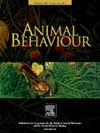Leveraging animal behaviour can improve translocation success in the face of anthropogenic stressors
IF 2.1
2区 生物学
Q2 BEHAVIORAL SCIENCES
引用次数: 0
Abstract
Anthropogenic stressors, such as habitat loss and fragmentation, destabilize animal populations, putting species at risk of extirpation or extinction. Conservation translocations, i.e. moving animals from one area of their native habitat to create new populations or bolster existing populations in other areas, are increasingly necessary to combat species decline. However, translocation success is variable, and failure is common, regardless of the resources invested in the programme. Additional anthropogenic stressors, such as climate change, pollution, harvesting, invasive species and human–wildlife conflict, further complicate the translocation process. Methods to reduce variable results and increase success are needed, and incorporating animal behaviour and its relevant theories has that potential. We reviewed cases where animal behaviour contributed to the success or failure of a translocation programme where anthropogenic stressors (in particular, climate change, pollution, harvesting, invasive species and human–wildlife conflict) contributed to or were the driving force of the programme's outcome. We further identify areas where conservation behaviour could be implemented to improve the success of translocation programmes and highlight why we need to better leverage our knowledge of animal behaviour to improve the success of translocations in a rapidly changing environment.
在面对人为压力时,利用动物行为可以提高易位的成功率
人为的压力因素,如栖息地的丧失和破碎化,破坏了动物种群的稳定,使物种面临灭绝或灭绝的危险。保护易位,即将动物从其原生栖息地的一个地区转移到其他地区创造新的种群或支持现有种群,对于对抗物种衰退越来越有必要。然而,无论在项目中投入多少资源,易位成功与否是可变的,失败是常见的。其他人为压力因素,如气候变化、污染、采伐、入侵物种和人类与野生动物的冲突,使迁移过程进一步复杂化。减少可变结果和提高成功率的方法是必要的,结合动物行为及其相关理论具有这种潜力。我们回顾了动物行为对迁移计划的成功或失败做出贡献的案例,其中人为压力因素(特别是气候变化、污染、收获、入侵物种和人类与野生动物的冲突)促成或推动了该计划的结果。我们进一步确定了可以实施保护行为的领域,以提高易位计划的成功率,并强调了为什么我们需要更好地利用我们对动物行为的了解,以提高在快速变化的环境中易位的成功率。
本文章由计算机程序翻译,如有差异,请以英文原文为准。
求助全文
约1分钟内获得全文
求助全文
来源期刊

Animal Behaviour
生物-动物学
CiteScore
4.60
自引率
8.00%
发文量
236
审稿时长
10.2 weeks
期刊介绍:
Growing interest in behavioural biology and the international reputation of Animal Behaviour prompted an expansion to monthly publication in 1989. Animal Behaviour continues to be the journal of choice for biologists, ethologists, psychologists, physiologists, and veterinarians with an interest in the subject.
 求助内容:
求助内容: 应助结果提醒方式:
应助结果提醒方式:


